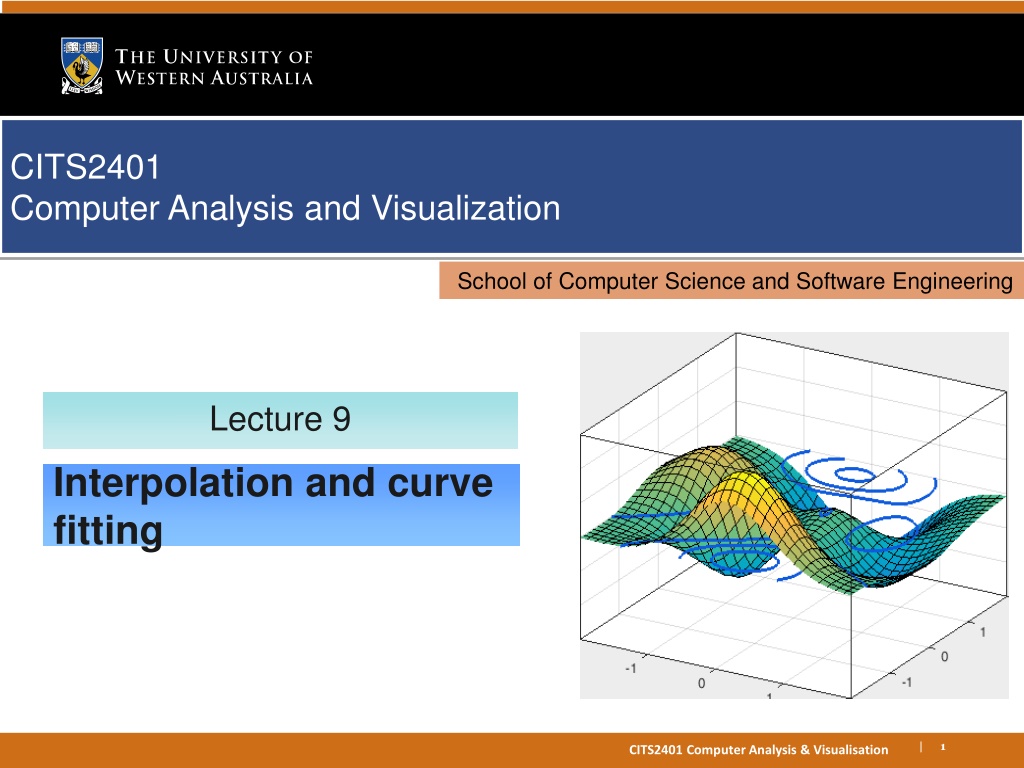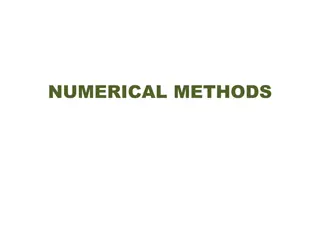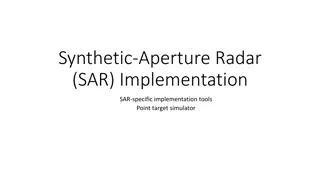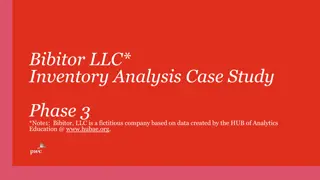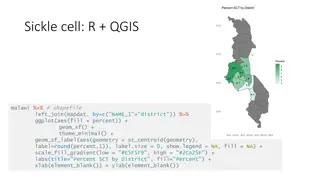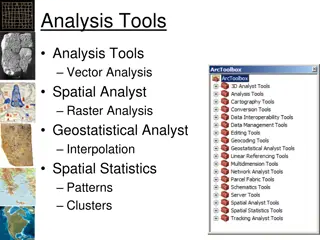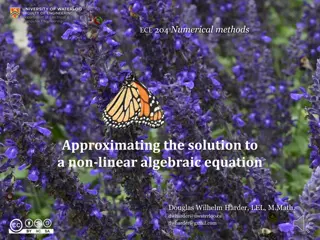Understanding Interpolation Techniques in Computer Analysis & Visualization
Explore the concepts of interpolation and curve fitting in computer analysis and visualization. Learn about linear regression, polynomial regression, and multiple variable regression. Dive into linear interpolation techniques and see how to apply them in Python using numpy. Uncover the basics of finding points between known data points and predicting values through interpolation.
Download Presentation

Please find below an Image/Link to download the presentation.
The content on the website is provided AS IS for your information and personal use only. It may not be sold, licensed, or shared on other websites without obtaining consent from the author. Download presentation by click this link. If you encounter any issues during the download, it is possible that the publisher has removed the file from their server.
E N D
Presentation Transcript
CITS2401 Computer Analysis and Visualization School of Computer Science and Software Engineering Lecture 9 Interpolation and curve fitting | 1 CITS2401 Computer Analysis & Visualisation
Summary Interpolation Curve fitting Linear regression (for single variables) Polynomial regression Multiple variable regression Non-linear terms in regression | 2 CITS2401 Computer Analysis & Visualisation
Interpolation Suppose you have some known data points, and you wish to predict what other data points might be how can you do this? For example: If at t = 1 second, distance traveled = 2m, and at t = 5 seconds, distance traveled = 10m ... What would be the distance traveled at, say, t = 3 seconds? | 3 CITS2401 Computer Analysis & Visualisation
Linear interpolation The simplest interpolation technique is linear interpolation: it assumes that data follows a straight line between adjacent measurements. | 4 CITS2401 Computer Analysis & Visualisation
Linear interpolation (2) Assume the function between two points is a straight line Find equation of the line that passes through the two points How do you find a point in between? Put a value of x in the equation to find y X=2, Y=? Put a value of y in the equation to find x | 5 CITS2401 Computer Analysis & Visualisation
Linear interpolation in python numpy.interp(x, xp, yp): xp and yp give the x and y coordinates of the data points we have x contains the x coordinates that we want interpolated y-values for. | 6 CITS2401 Computer Analysis & Visualisation
Linear interpolation in python example Linear interpolation of the sin() function: >>> importnumpyasnp >>> importmatplotlib.pyplotasplt >>> x_pts = np.linspace(0, 2*np.pi, 10) # 10 equidistant x coords from 0 to 10 >>> y_pts = np.sin(x_pts) >>> x_vals = np.linspace(0, 2*np.pi, 50) # 50 desired points >>> y_vals = np.interp(x_vals, x_pts, y_pts) >>> plt.plot(x_pts, y_pts, 'o') # plot known data points >>> plt.plot(x_vals, y_vals, '-x') # plot interpolated points >>> plt.show() | 7 CITS2401 Computer Analysis & Visualisation
Linear interpolation in python example (2) | 8 CITS2401 Computer Analysis & Visualisation
Cubic spline interpolation Just as a linear interpolation is made up of linear segments a cubic spline interpolation is made of segments of cubic polynomials, whose gradients match up at the measured data points. These cubic polynomials are continuous up to their 2nd derivative. | 9 CITS2401 Computer Analysis & Visualisation
Cubic spline interpolation (2) Using numpy and scipy, interpolation is done in 2 steps: scipy.interpolate.splrep(x_pts, y_pts) returns a tuple representing the spline formulas needed scipy.interpolate.splev(x_vals, splines) ("spline evaluate") evaluate the spline data returned by splrep, and use it to estimate y values. | 10 CITS2401 Computer Analysis & Visualisation
Cubic spline interpolation example >>> importnumpyasnp >>> fromscipyimport interpolate >>> importmatplotlib.pyplotasplt >>> x_pts = np.linspace(0, 2*np.pi, 10) # 10 equidistant x coords from 0 to 10 >>> y_pts = np.sin(x_pts) >>> splines = interpolate.splrep(x_pts, y_pts) >>> x_vals = np.linspace(0, 2*np.pi, 50) # 50 desired points >>> y_vals = interpolate.splev(x_vals, splines) >>> plt.plot(x_pts, y_pts, 'o') # plot known data points >>> plt.plot(x_vals, y_vals, '-x') # plot interpolated points >>> plt.show() | 11 CITS2401 Computer Analysis & Visualisation
Cubic spline interpolation example (2) | 12 CITS2401 Computer Analysis & Visualisation
2D interpolation Just as we can do linear interpolation to estimate y values given x values i.e. estimating a one-variable function f(x) we can also do linear interpolation of a two-variable function f(x,y). | 13 CITS2401 Computer Analysis & Visualisation
2D interpolation original data (1) We will generate some data, and demonstrate what the original data points look like, and the interpolated version. frommpl_toolkits.mplot3dimport axes3d, Axes3D importmatplotlib.pyplotasplt frommatplotlibimport cm importnumpyasnp frommatplotlib.mlabimport bivariate_normal ... | 14 CITS2401 Computer Analysis & Visualisation
2D interpolation original data (2) ... # a function to plot the surface. # x, y and z should be arrays of data def plot_data(x, y, z): fig = plt.figure() #ax = fig.gca(projection='3d') ax = Axes3D(fig) surf = ax.plot_surface(x, y, z, cmap=cm.coolwarm, linewidth=0, antialiased=False) plt.show() | 15 CITS2401 Computer Analysis & Visualisation
2D interpolation original data (3) >>> x_pts = np.arange(-3, 3, 1) >>> y_pts = np.arange(-3, 3, 1) >>> xx, yy = np.meshgrid(x_pts, y_pts) # the plotting functions require the x and # y values in a grid format >>> zz = np.sin(xx) + np.cos(yy) >>> plot_data(xx,yy,zz) | 16 CITS2401 Computer Analysis & Visualisation
2D interpolation original data (4) | 17 CITS2401 Computer Analysis & Visualisation
2D interpolation linearly interpolated data Now we'll perform linear interpolation. interpolate.interp2d(x, y, z, kind='linear') returns a function which, when called, returns the actual interpolated values. >>> fromscipyimport interpolate >>> f = interpolate.interp2d(x_pts, y_pts, zz, kind='linear') # "kind" specifies whether we're doing linear, cubic, etc. >>> x_vals = np.arange(-3, 3, 0.1) >>> y_vals = np.arange(-3, 3, 0.1) >>> xx_v, yy_v = np.meshgrid(x_vals, y_vals) >>> zz_v = f(x_vals, y_vals) >>> plot_data(xx_v,yy_v,zz_v) | 18 CITS2401 Computer Analysis & Visualisation
2D interpolation linearly interpolated data (2) | 19 CITS2401 Computer Analysis & Visualisation
2D interpolation cubic interpolated data Now we'll perform cubic interpolation. interpolate.interp2d(x, y, z, kind='linear') returns a function which, when called, returns the actual interpolated values. >>> fromscipyimport interpolate >>> f = interpolate.interp2d(x_pts, y_pts, zz, kind='cubic') >>> x_vals = np.arange(-3, 3, 0.1) >>> y_vals = np.arange(-3, 3, 0.1) >>> xx_v, yy_v = np.meshgrid(x_vals, y_vals) >>> zz_v = f(x_vals, y_vals) >>> plot_data(xx_v,yy_v,zz_v) | 20 CITS2401 Computer Analysis & Visualisation
2D interpolation cubic interpolated data (2) | 21 CITS2401 Computer Analysis & Visualisation
Curve fitting Collected data always contains some degree of error or imprecision Whereas interpolation is used when we assume that all data points are accurate and we want to infer new intermediate data points curve fitting is used when we want to match an analytical (or symbolic) model to a set of measurements which may contain some error. | 22 CITS2401 Computer Analysis & Visualisation
Curve fitting (2) For instance, we may have data points which seem to represent noisy data obtained from an underlying linear relationship how can we estimate or model that underlying relationship? | 23 CITS2401 Computer Analysis & Visualisation
Linear regression One method of curve fitting is linear regression it minimizes the "square of the errors" (where the "error" is the distance each point is from the line). (In Excel, there is a function called "SLOPE" which performs linear regression on a set of data points, similar to the Python functions we will see here.) | 24 CITS2401 Computer Analysis & Visualisation
Polynomial regression Linear regression is a special case of polynomial regression since a line (i.e., an equation of the form ax + b) is a simple polynomial. But your data may not reflect a linear relationship a polynomial of a higher order may be a better fit. | 25 CITS2401 Computer Analysis & Visualisation
Linear regression (2) Both linear and non-linear polynomial regression can be done with Numpy's polyfit function: numpy.polyfit(x, y, degree) It returns the coeffficients for the polynomial; the easiest way to then use these in code is to use the numpy.poly1d class. >>> importnumpyasnp >>> fromscipy.statsimport linregress >>> x_pts = np.arange(0,6,1) >>> y_pts = np.array([15, 10, 9, 6, 2, 0]) >>> f = np.poly1d( np.polyfit(x_pts, y_pts, 1)) # linear regression >>> x_vals = np.linspace(0, 6, 100) >>> plt.plot(x_pts, y_pts, '.') >>> plt.plot(x_vals, f(x_vals), '-') | 26 CITS2401 Computer Analysis & Visualisation
Linear regression (3) | 27 CITS2401 Computer Analysis & Visualisation
Polynomial regression If we have 6 data points, then a fifth-order polynomial will be able to give a perfect fit for them (i.e., there is some fifth-order polynomial on which all the data points fall exactly). >>> importnumpyasnp >>> fromscipy.statsimport linregress >>> x_pts = np.arange(0,6,1) >>> y_pts = np.array([15, 10, 9, 6, 2, 0]) >>> f = np.poly1d( np.polyfit(x_pts, y_pts, 5)) # 5th-order polynomial >>> x_vals = np.linspace(0, 6, 100) >>> plt.plot(x_pts, y_pts, '.') >>> plt.plot(x_vals, f(x_vals), '-') | 28 CITS2401 Computer Analysis & Visualisation
Polynomial regression (2) | 29 CITS2401 Computer Analysis & Visualisation
Interpolation and curve fitting part 2 | 30 CITS2401 Computer Analysis & Visualisation
Overview Multiple variable regression Non-linear terms in regression | 31 CITS2401 Computer Analysis & Visualisation
Multiple variable data In our regression examples, we have used models where a single output variable changes with respect to a single input variable.But real data may have multiple input variables. For example, the top speed of a vehicle will depend on many variables such as engine size, weight, air resistance etc. | 32 CITS2401 Computer Analysis & Visualisation
Predictor and response variables The input variables are called the independent variables, OR predictor variables, OR experimental variables The output variable is referred to as the dependent variable, OR response variable, OR outcome variable | 33 CITS2401 Computer Analysis & Visualisation
Predictor and response variables (2) We can use regression to find the relationship between input and output variables. We will use the following for our data points: importnumpyasnp x_pts = np.arange(-5,5,0.5) y_pts = np.arange(-5,5,0.5) xx, yy = np.meshgrid(x_pts, y_pts) # our dependent variable is a linear function of # x and y, plus random noise. zz = 3*xx - 0.5*yy - 5 + 8 * np.random.normal(size=xx.shape) | 34 CITS2401 Computer Analysis & Visualisation
Predictor and response variables (3) We build a model i.e., we estimate the coefficients for x, y and intercept by expressing our data as a matrix equation, and getting Python to give us a "least squares" solution for it. The lstsq function from Numpy will return a range of information about the solution as a tuple the coefficients we want are the first member of that tuple: numpy.linalg.lstsq(independent_vars, dependent_var) e.g.: model_coefficients = numpy.linalg.lstsq(independent_vars, dependent_var)[0] | 35 CITS2401 Computer Analysis & Visualisation
Predictor and response variables (4) Let's see what our input data looks like: frommpl_toolkits.mplot3dimport axes3d, Axes3D importmatplotlib.pyplotasplt fromnumpy.linalgimport lstsq def plot_points(x, y, z): fig = plt.figure() ax = fig.gca(projection='3d') surf = ax.plot_surface(x, y, z, cmap=plt.cm.coolwarm) ax.view_init(20, -120) plt.show() plot_points(xx,yy,zz) | 36 CITS2401 Computer Analysis & Visualisation
Predictor and response variables (5) | 37 CITS2401 Computer Analysis & Visualisation
Predictor and response variables (6) To estimate the coefficients in our underlying relationship, we will ask Python to solve a matrix equation of the form where D is a matrix of representing our observations of independent variables, c are the unknown coefficients we want to estimate, and z represents our observations of the z values. So that Python will estimate values of the intercept the "-5" in our underlying relationship we will need a column of ones in the D matrix. So the equation will look like: | 38 CITS2401 Computer Analysis & Visualisation
Predictor and response variables (7) # matrix for observations of independent variables >>> ones = [ [1] * len( xx.flatten() )] >>> indep = np.column_stack( [xx.flatten(), yy.flatten()] + ones ) >>> model = lstsq(indep, zz.flatten())[0] >>> model array([ 3.27248794, -0.6004752 , -5.26689769]) Compare the estimated coefficients with the actual ones (3, -0.5 and -5). | 39 CITS2401 Computer Analysis & Visualisation
Predictor and response variables (8) We can plot the least squares solution: >>> x_vals = np.arange(-5,5,0.1) >>> y_vals = np.arange(-5,5,0.1) >>> xx_vals, yy_vals = np.meshgrid(x_vals, y_vals) >>> zz_vals = model[0] * xx_vals + model[1] * yy_vals + model[2] >>> fig = plt.figure() >>> ax = fig.gca(projection='3d') >>> ax.plot_surface(xx_vals, yy_vals, zz_vals, cmap=plt.cm.coolwarm) # the surface is our least-squares estimate >>> ax.scatter( xx, yy, zz) # the scatter plot shows our original data points >>> ax.view_init(20, -120) >>> plt.show() | 40 CITS2401 Computer Analysis & Visualisation
Predictor and response variables (9) | 41 CITS2401 Computer Analysis & Visualisation
Curve-fitting using non-linear terms in linear regression What if we have a non-linear relationship between our variables? We can actually still use linear regression, as we did in the previous example: but in our matrix of independent variables, we'll include terms which are a non-linear function of our observations. >>> xx_flat = xx.flatten() >>> yy_flat = yy.flatten() >>> zz_flat = zz.flatten() >>> ones = [ [1] * len( xx_flat )] >>> indep = np.column_stack( [xx_flat, yy_flat, 3 * np.sin(2 * xx_flat) ] + ones ) # the 3rd column is *3sin(2x)* >>> model = lstsq(indep, zz.flatten())[0] >>> model array([ 2.88268949, -0.30450846, -0.02530611, -4.46351387]) | 42 CITS2401 Computer Analysis & Visualisation
Curve-fitting using non-linear terms in linear regression (2) As with the linear case, we can use this model to estimate z-values. >>> x_vals = np.arange(-5,5,0.1) >>> y_vals = np.arange(-5,5,0.1) >>> xx_vals, yy_vals = np.meshgrid(x_vals, y_vals) >>> zz_vals = model[0] * xx_vals + model[1] * yy_vals + model[2] * 3 * np.sin(2 * xx_vals) + model[3] >>> fig = plt.figure() >>> ax = fig.gca(projection='3d') >>> ax.plot_surface(xx_vals, yy_vals, zz_vals, cmap=plt.cm.coolwarm) # the surface is our least-squares estimate >>> ax.scatter( xx, yy, zz) # the scatter plot shows our original data points >>> ax.view_init(20, -120) >>> plt.show() | 43 CITS2401 Computer Analysis & Visualisation
Curve-fitting using non-linear terms in linear regression (3) | 44 CITS2401 Computer Analysis & Visualisation
